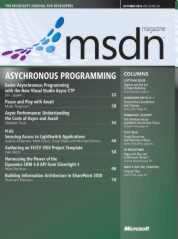| MSDN Magazine October 2011 - Async |
| Written by Ian Elliot |
| Sunday, 09 October 2011 |
|
The October issue of MSDN Magazine is now available online with a mixed bag of articles to read. Asynchronous programming is the focus of this months MSDN magazine and it is a hot topic given it is such an old problem. Don't confuse the async problem with the multi-threading problem. In asynchronous programming is all about freeing up a single thread to get on with useful work when it cannot get on with something. It is about not leaving the thread sitting waiting for something. As such it is something that should be taken care off behind the scenes and to a certain extent the next async commands in .NET return the asynchronous flow back where it belongs - i.e. hidden in the compiler. The problem is that people who describe the new ideas want you to know just how clever the whole idea is and this makes it seem more complex. If you simply want to use the async facilities then you don't really need to have a deep understanding of what is going on. The articles in this month's MSDN Magazine explain things in perhaps too much depth if all you want to do is make use of the new facilities.
Easier Asynchronous Programming with the New Visual Studio Async CTP by Eric Lippert for example explains what the need for asynchronous programming is - i.e. your flow of control has to wait while another process is being completed and then goes over the different ways of dealing with the situation - DoEvents, callbacks and finally task-based asynchrony which basically gives the problem of constructing a callback to the compiler. It is a nice introduction which is followed up by Pause and Play with Await which is a more in-depth look a the same ideas using C#. Here you can also discover how to make your own methods awaitable and how it works. The third article on the topic is even deeper and takes a look at Async Performance: Understanding the Costs of Async and Await for many this is going to be too deep. You don't have to know this to get some really useful value out of the asynchronous commands but if you are curious and worried about efficiency you need to read this. The rest of the issue is a collection of topical items. We have Securing Access to LightSwitch Applications, which given LightSwitch is supposed to be for non-programmers proves the point that programmers are still needed.
Creating a template for Visual Studio isn't something we all need to do, but if you do then the article: Authoring an F#/C# VSIX Project Template will help. Talking about minority, but important topics, we have a discussion of Harnessing the Power of the Dynamics CRM 4.0 API from Silverlight 4. It is good to know that Silverlight 4 is still welcome in Dynamics CRM and in MSDN Magazine. Building Information Architecture in SharePoint 2010 explains how the new Enterprise Content Management features in SharePoint 2010 can be used. There are also two article in the online version which are about HTML5. Browser and Feature Detection which is pretty basic stuff unless you are new to writing browser-independent JavaScript and only really serves to raise the question of why you aren't using a library. The second article, Writing a Business-Oriented JavaScript Web Application, demonstrates the use of Sammy.js to implement an MVC type structure. If you don't know about MVC or Sammy.js then you probably are going to find this article hard work. It isn't an overview or a look at philosophy, but a list of how something was coded. The magazine closes with the usual regular columns. Notable are Dino Esposito's look at data modeling and the Entity Framework and Charles Petzold's approach to the tricky problem of pages and pop-ups in Windows Phone 7. What is notably absent from MSDN Magazine this month is any mention of programming for Window 8. Surely this is a missed opportunity? There is also the fact that the increasing diversity of Microsoft's approach to programming is making the magazine look distinctly like a collection of random ideas - this can only get worse in the near future. (At the time of writing there were a lot of typos and missing lines from listings in the issue - presumably this will be fixed in no time at all.) More Infomation:
To be informed about new articles on I Programmer, subscribe to the RSS feed, follow us on Twitter or Facebook or sign up for our weekly newsletter.
|
| Last Updated ( Sunday, 09 October 2011 ) |



